Changing Patterns of Global Agri-Food Trade and the Economic Efficiency of Virtual Water Flows
Abstract
:1. Introduction
2. Results
2.1. Interregional Trade and VW Flows
| Export Value | Import Value | Net Export Value | VW Outflows | VW Inflows | Net VW Inflows | |||||||
|---|---|---|---|---|---|---|---|---|---|---|---|---|
| (Billion USD) | (Billion USD) | (Billion USD) | (km3) | (km3) | (km3) | |||||||
| 1986 | 2011 | 1986 | 2011 | 1986 | 2011 | 1986 | 2011 | 1986 | 2011 | 1986 | 2011 | |
| Africa | 2.1 | 7.7 | 6.1 | 19.7 | −4.1 | −12.1 | 7.9 | 38.0 | 35.8 | 96.7 | 27.9 | 58.7 |
| Asia | 9.0 | 28.3 | 21.5 | 95.1 | −12.5 | −66.8 | 60.2 | 148.7 | 129.9 | 389.6 | 69.7 | 240.9 |
| Europe | 20.8 | 49.6 | 38.1 | 62.1 | −17.3 | −12.5 | 60.5 | 85.0 | 192.4 | 256.7 | 132.0 | 171.7 |
| N-America | 26.7 | 69.9 | 22.8 | 42.8 | 3.9 | 27.1 | 204.1 | 314.6 | 71.0 | 98.2 | −133.0 | −216.3 |
| S-America | 18.7 | 86.9 | 5.0 | 16.7 | 13.8 | 70.2 | 105.4 | 396.6 | 32.3 | 75.8 | −73.1 | −320.8 |
| Global | 77.2 | 242.3 | 93.5 | 236.4 | −16.2 | 5.9 | 438.0 | 982.8 | 461.5 | 917.0 | 23.5 | −65.8 |
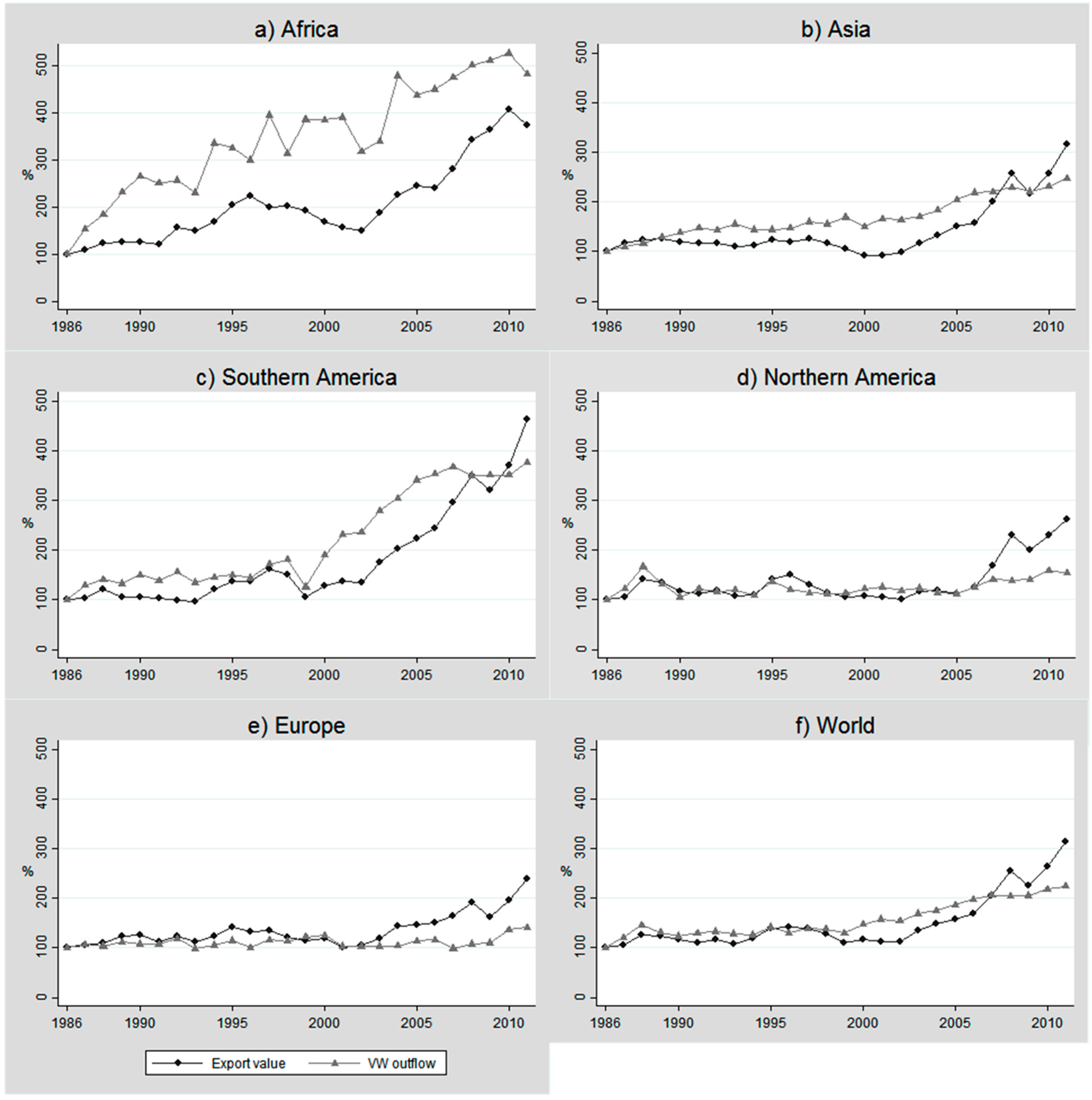
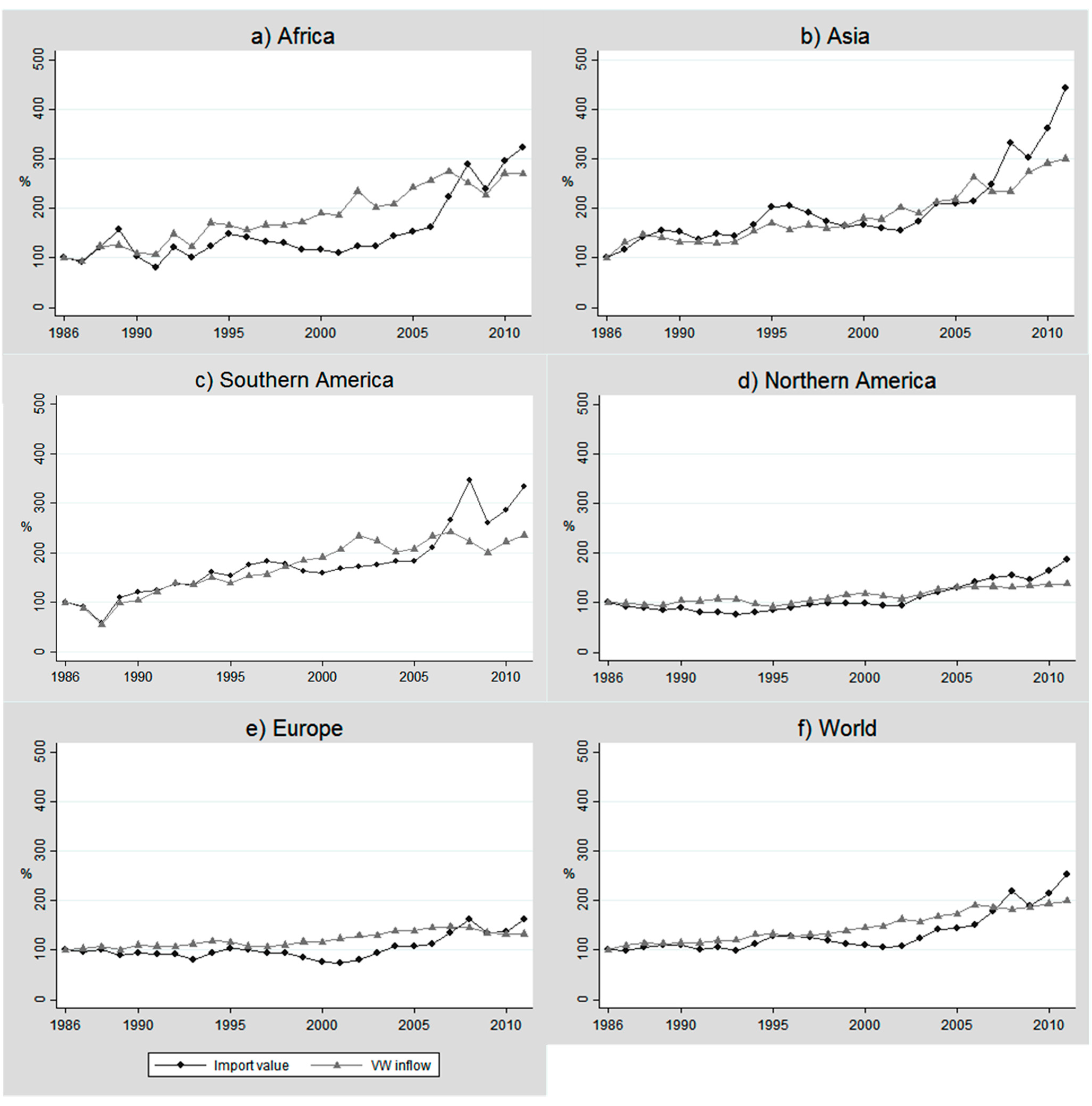
2.2. Composition of Trade and VW Flows
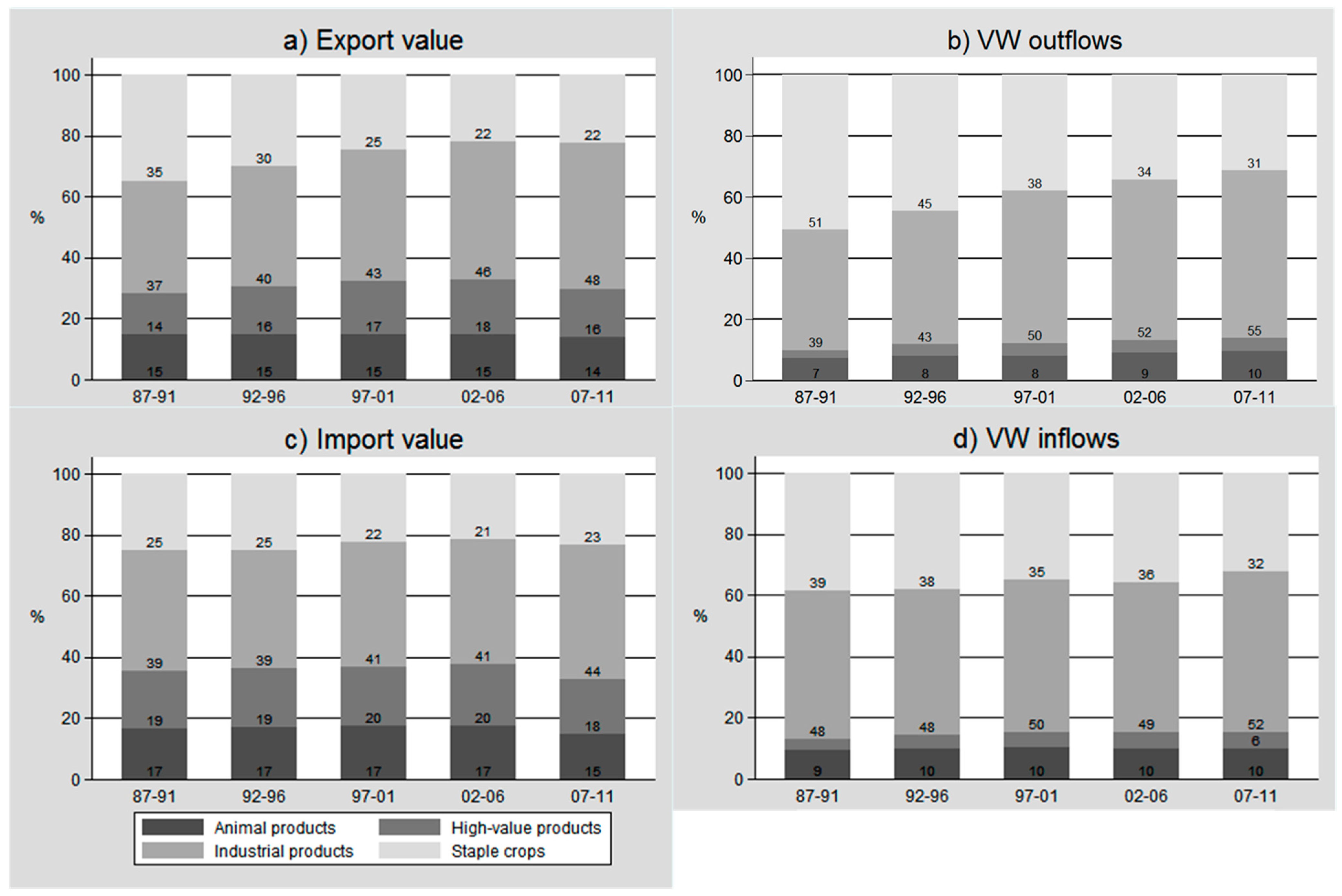
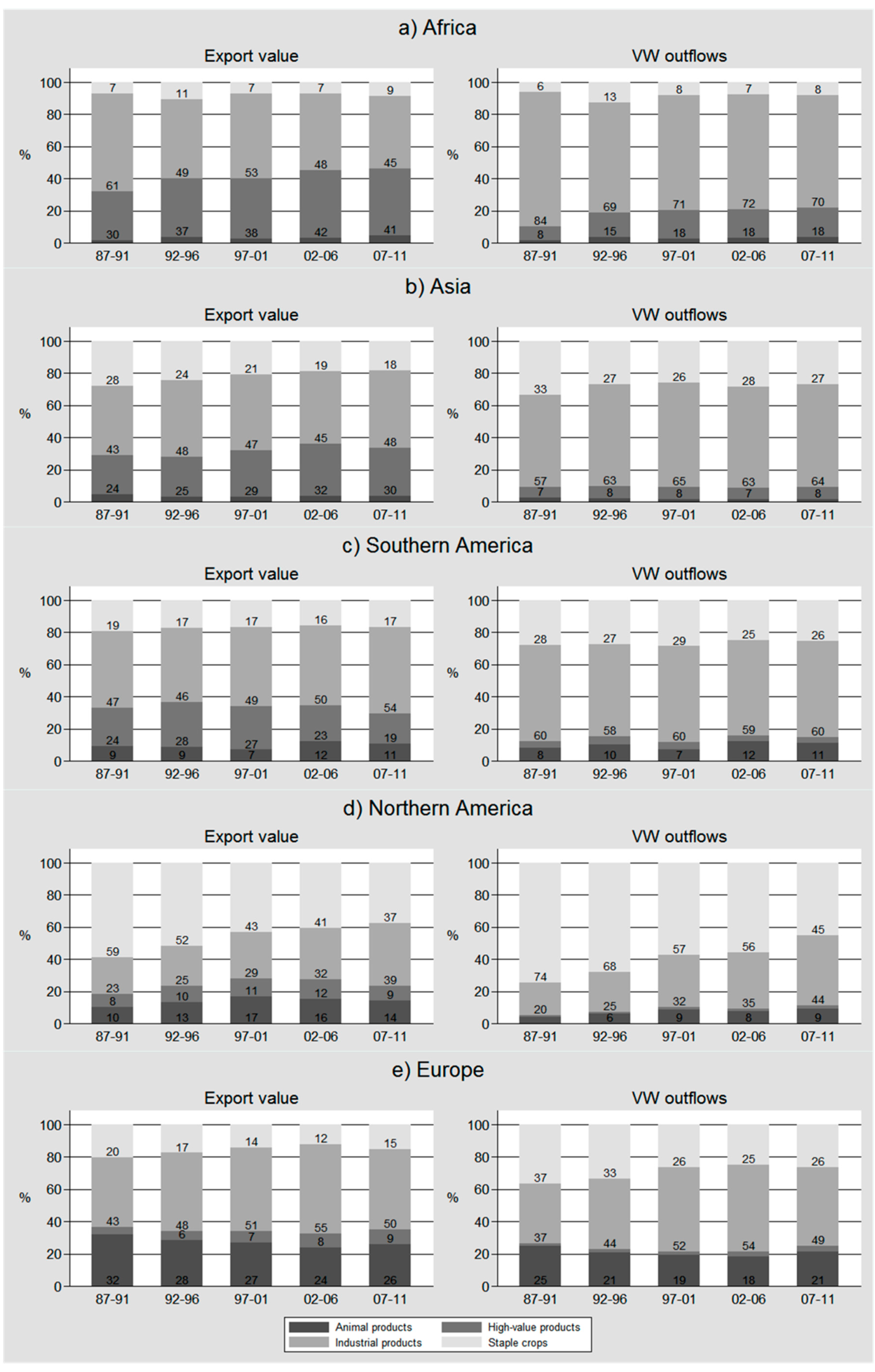
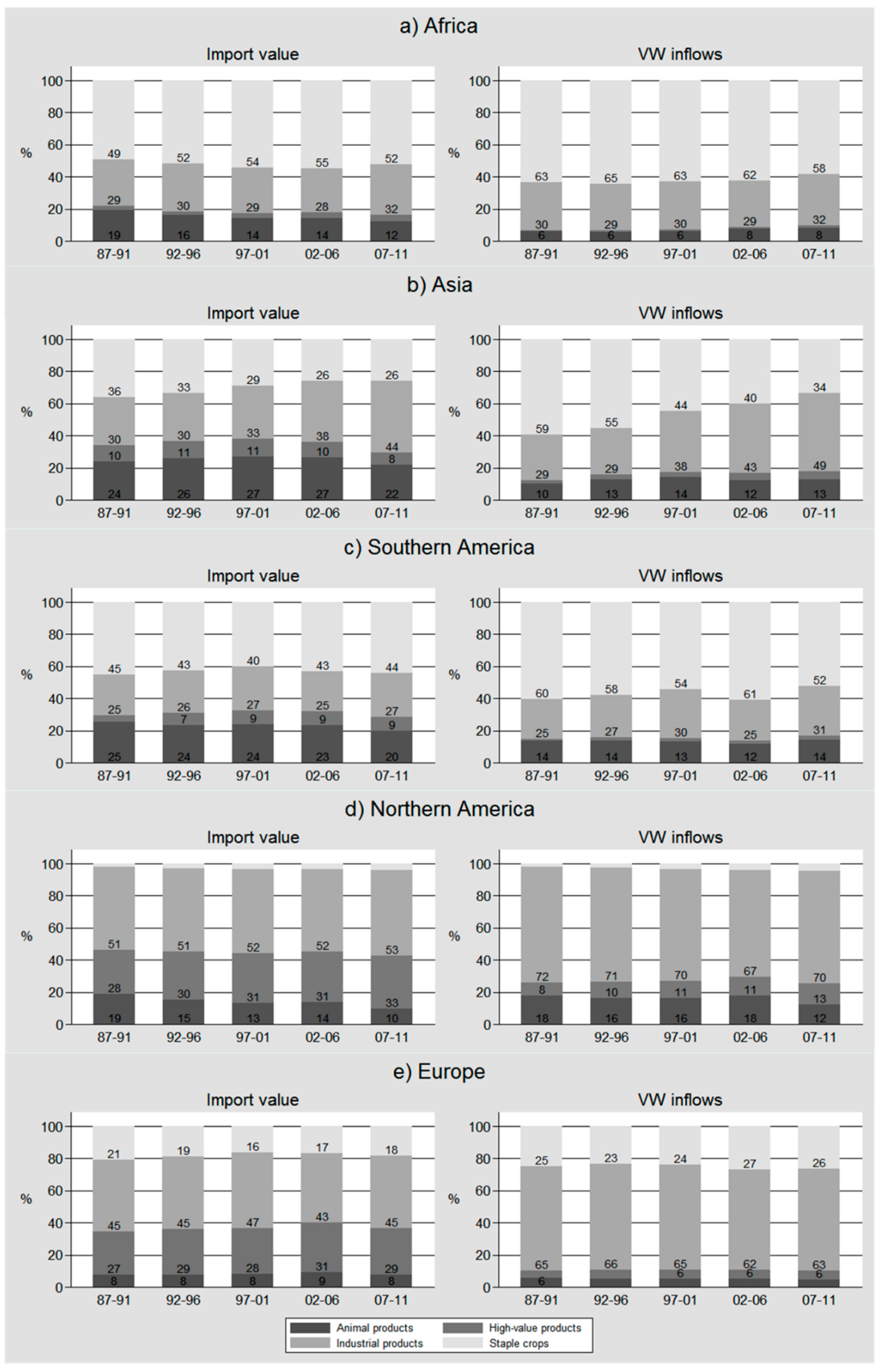
2.3. Economic Efficiency of VW Flows
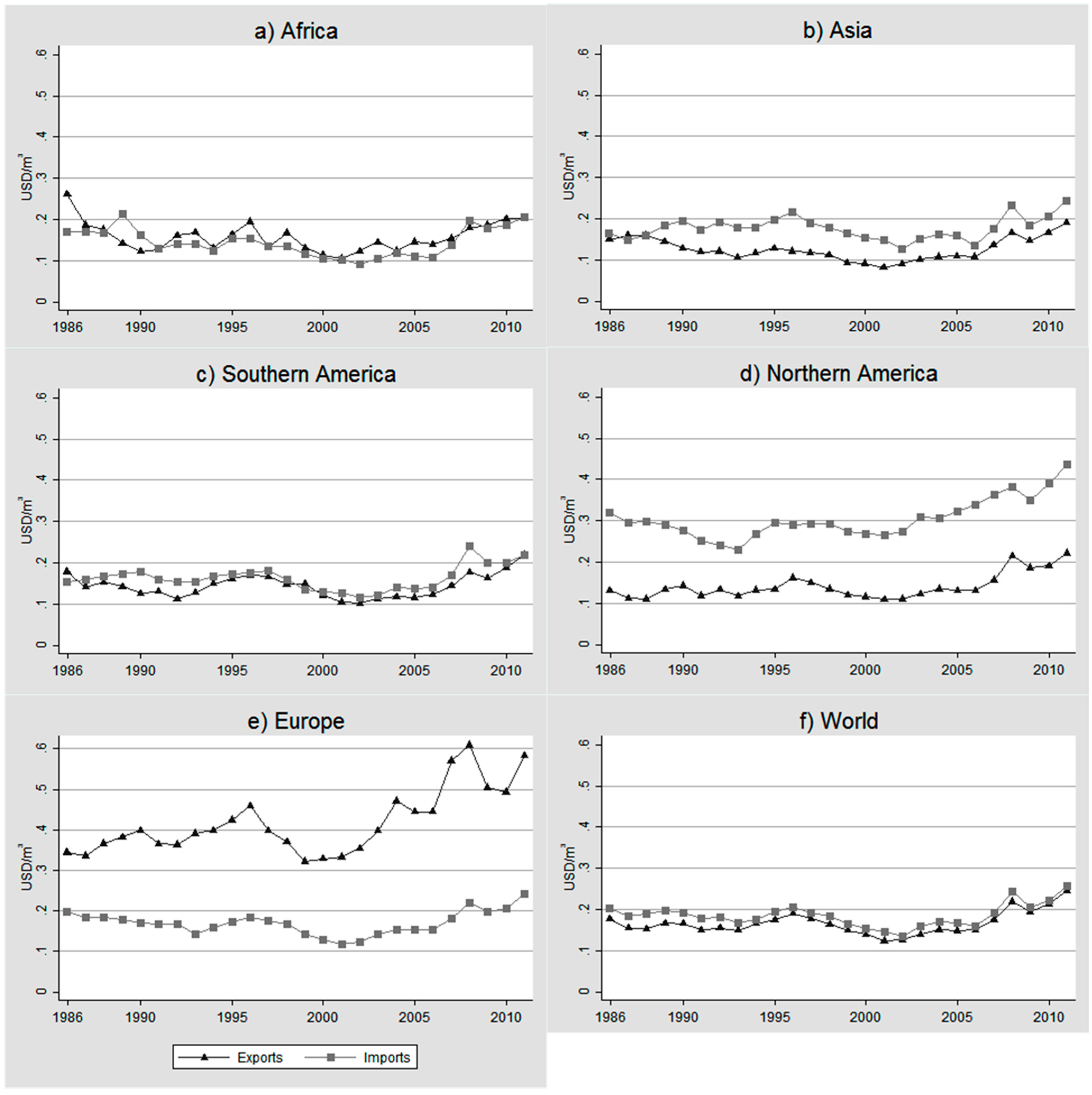
3. Discussion
4. Material and Methods
4.1. Calculation of Trade Values, Virtual Water Flows and Economic Water Efficiency
4.2. Data Sources
4.3. Classification of Products and Countries
5. Conclusions
Acknowledgments
Author Contributions
Supplementary Materials
Conflicts of Interest
References
- Anderson, K. Globalization’s effects on world agricultural trade, 1960–2050. Phil. Trans. R. Soc. B 2010, 365, 3007–3021. [Google Scholar] [CrossRef] [PubMed]
- FAOSTAT Online Database. Available online: http://faostat3.fao.org (accessed on 20 October 2014).
- Aksoy, M.A. The evolution of agricultural trade flows. In Global Agricultural Trade and Developing Countries; Aksoy, M.A., Beghin, J.C., Eds.; The World Bank: Washington, DC, USA, 2005; pp. 17–34. [Google Scholar]
- Maertens, M.; Minten, B.; Swinnen, J.F. Modern food supply chains and development. Evidence from horticultural export sectors in Sub-Saharan Africa. Dev. Policy Rev. 2012, 30, 473–497. [Google Scholar] [CrossRef]
- World Bank. World Development Report 2008. Agriculture for Development; The World Bank: Washington, DC, USA, 2007. [Google Scholar]
- Diop, N.; Jaffee, S.M. Fruits and vegetables. Global trade dynamics, and the impact of trade liberalization. In Global Agricultural Trade and Developing Countries; Aksoy, M.A., Beghin, J.C., Eds.; The World Bank: Washington, DC, USA, 2005; pp. 17–34. [Google Scholar]
- Reardon, T.; Barrett, C.B.; Berdegué, J.A.; Swinnen, J.F. Agrifood industry transformation and small farmers in developing countries. World Dev. 2009, 37, 1717–1727. [Google Scholar] [CrossRef]
- Pingali, P. Agricultural growth and economic development. A view through the globalization lens. Agric. Econ. 2007, 37, 1–12. [Google Scholar] [CrossRef]
- Aksoy, M.A.; Beghin, J.C. Global Agricultural Trade and Developing Countries; The World Bank: Washington, DC, USA, 2005. [Google Scholar]
- Dollar, D.; Kraay, A. Trade, growth, and poverty. Econ. J. 2004, 114, 22–39. [Google Scholar] [CrossRef]
- Rao, E.J.; Qaim, M. Supermarkets, farm household income, and poverty. Insights from Kenya. World Dev. 2011, 39, 784–796. [Google Scholar] [CrossRef]
- Miyata, S.; Minot, N.; Hu, D. Impact of contract farming on income. Linking small farmers, packers, and supermarkets in China. World Dev. 2009, 37, 1781–1790. [Google Scholar] [CrossRef]
- Ramaswami, B.; Birthal, P.S.; Joshi, P.K. Grower heterogeneity and the gains from contract farming. The case of Indian poultry. Indian Growth Dev. Rev. 2009, 2, 56–74. [Google Scholar] [CrossRef]
- Rao, E.J.; Brümmer, B.; Qaim, M. Farmer participation in supermarket channels, production technology, and efficiency. The case of vegetables in Kenya. Am. J. Agric. Econ. 2012, 94, 891–912. [Google Scholar] [CrossRef]
- Dries, L.; Swinnen, J.F. Foreign direct investment, vertical integration, and local suppliers. Evidence from the Polish dairy sector. World Dev. 2004, 32, 491–509. [Google Scholar] [CrossRef]
- Maertens, M.; Swinnen, J.F. Trade, standards, and poverty. Evidence from Senegal. World Dev. 2009, 37, 161–178. [Google Scholar] [CrossRef]
- Minten, B.; Randrianarison, L.; Swinnen, J.F. Global retail chains and poor farmers. Evidence from Madagascar. World Dev. 2009, 37, 1728–1741. [Google Scholar] [CrossRef]
- Christiaensen, L.; Devarajan, S. Making the most of Africa’s growth. Curr. Hist. 2013, 112, 181–187. [Google Scholar]
- Minten, B.; Murshid, K.A.; Reardon, T. Food quality changes and implications. Evidence from the rice value chain of Bangladesh. World Dev. 2013, 42, 100–113. [Google Scholar] [CrossRef]
- Diao, X.; Hazell, P.; Thurlow, J. The role of agriculture in African development. World Dev. 2010, 38, 1375–1383. [Google Scholar] [CrossRef]
- Reardon, T.; Chen, K.Z.; Minten, B.; Adriano, L. The Quiet Revolution in Staple Food Value Chains in Asia; Enter the Dragon, the Elephant, and The Tiger; Asian Development Bank and International Food Policy Research Institute: Mandaluyong, PH, USA, 2012. [Google Scholar]
- Rakotoarisoa, M.A. Why Has Africa Become a Net Food Importer? Explaining Africa Agricultural and Food Trade Deficits; Food and Agriculture Organization of the United Nations: Rome, Italy, 2011. [Google Scholar]
- Edwards-Jones, G.; Milà I Canals, L.; Hounsome, N.; Truninger, M.; Koerber, G.; Hounsome, B.; Cross, P.; York, E.H.; Hospido, A.; Plassmann, K.; et al. Testing the assertion that “local food is best”. The challenges of an evidence-based approach. Food Sci. Technol. 2008, 19, 265–274. [Google Scholar] [CrossRef]
- MacGregor, J.; Vorley, B. Fair miles? The concept of “food miles” through a sustainable development lens. In IIED Sustainable Development Opinion; International Institute for Environment and Development: London, UK, 2006. [Google Scholar]
- Peters, G.P.; Minx, J.C.; Weber, C.L.; Edenhofer, O. Growth in emission transfers via international trade from 1990 to 2008. PNAS 2011, 108, 8903–8908. [Google Scholar] [CrossRef] [PubMed]
- Hertwich, E.G.; Peters, G.P. Carbon footprint of nations: A global, trade-linked analysis. Environ. Sci. Technol. 2009, 43, 6414–6420. [Google Scholar] [CrossRef] [PubMed]
- Cristea, A.D.; Hummels, D.; Puzzello, L.; Avetisyan, M.G. Trade and the greenhouse gas emission from international freight transport. In NBER Working Paper Series No. 17117; National Bureau of Economic Research: Cambridge, MA, USA, 2011. [Google Scholar]
- Longo, S.; York, R. Agricultural exports and the environment. A cross-national study on fertilizer and pesticide consumption. Rural Sociol. 2008, 73, 82–104. [Google Scholar] [CrossRef]
- Murray, D.L. Export agriculture, ecological disruption, and social inequity. Some effects of pesticides in Southern Honduras. Agric. Hum. Values 1991, 8, 19–29. [Google Scholar] [CrossRef]
- Galt, R.E. Pesticides in export and domestic agriculture. Reconsidering market orientation and pesticide use in Costa Rica. Geoforum 2008, 39, 1378–1392. [Google Scholar] [CrossRef]
- UNESCO. United Nations World Water Development Report 2014. Water and Energy; UNESCO: Paris, France, 2014; Volume 1. [Google Scholar]
- Chapagain, A.K.; Hoekstra, A.Y. The global component of freshwater demand and supply. An assessment of virtual water flows between nations as a result of trade in agricultural and industrial products. Water Int. 2008, 33, 19–32. [Google Scholar] [CrossRef]
- Allan, J.A. Policy responses to the closure of water resources: Regional and global issues. In Water Policy: Allocation and Management in Practice; Howsam, P., Carter, R.C., Eds.; Chapman and Hall: London, UK, 1996; pp. 3–12. [Google Scholar]
- Allan, J.A. Virtual water: A strategic resource, global solutions to regional deficits. Groundwater 1998, 36, 545–546. [Google Scholar] [CrossRef]
- Hoekstra, A.Y.; Chapagain, A.K. Globalization of Water. Sharing the Planet’s Freshwater Resources; Blackwell Publishing: Oxford, UK, 2008. [Google Scholar]
- Hoekstra, A.Y.; Hung, P.Q. Globalisation of water resources. International virtual water flows in relation to crop trade. Glob. Environ. Chang. 2005, 15, 45–56. [Google Scholar] [CrossRef]
- Chapagain, A.K.; Hoekstra, A.Y.; Savenije, H.H.G. Water savings through international trade of agricultural products. Hydrol. Earth Syst. Sci. 2006, 10, 455–468. [Google Scholar] [CrossRef]
- Yang, H.; Wang, L.; Abbaspour, K.C.; Zehnder, A.J. Virtual water trade. An assessment of water use efficiency in the international food trade. Hydrol. Earth Syst. Sci. 2006, 10, 443–454. [Google Scholar] [CrossRef]
- Dalin, C.; Konar, M.; Kanasaki, N.; Rinaldo, A.; Rodriguez-Iturbe, I. Evolution of the global virtual water trade network. Proc. Natl. Acad. Sci. USA 2012, 109, 5989–5994. [Google Scholar] [CrossRef] [PubMed]
- Carr, J.A.; D’Odorico, P.; Laio, F.; Ridolfi, L. Recent history and geography of virtual water trade. PLoS ONE 2013, 8, 1–9. [Google Scholar]
- Konar, M.; Caylor, K.K. Virtual water trade and development in Africa. Hydrol. Earth Syst. Sci. 2013, 17, 3969–3982. [Google Scholar] [CrossRef]
- Duarte, R.; Pinilla, V.; Serrano, A. The effect of globalisation on water consumption. A case study of the Spanish virtual water trade, 1849–1935. Ecol. Econ. 2014, 100, 96–105. [Google Scholar] [CrossRef]
- Mekonnen, M.M.; Hoekstra, A.Y. The green, blue and grey water footprint of crops and derived crop products. Hydrol. Earth Syst. Sci. 2011, 15, 1577–1600. [Google Scholar] [CrossRef]
- Mekonnen, M.M.; Hoekstra, A.Y. A global assessment of the water footprint of farm animal products. Ecosystems 2012, 15, 401–415. [Google Scholar] [CrossRef]
- Gassert, F.; Reig, P.; Luo, T.; Maddocks, A. Aqueduct country and river basin rankings. In A Weighted Aggregation of Spatially Distinct Hydrological Indicators; Working Paper; World Resources Institute: Washington, DC, USA, 2013. [Google Scholar]
- Hoekstra, A.Y.; Chapagain, A.K. Water footprint of nations. Water use by people as function of their consumption pattern. Water Resour. Manag. 2007, 21, 35–48. [Google Scholar] [CrossRef]
- FAO. Technical Conversion Factors for Agricultural Commodities; Food and Agriculture Organization of the United Nations: Rome, Italy, 2003. [Google Scholar]
- FAOSTAT Commodity Definitions and Correspondences. Available online: http://www.fao.org/economic/ess/ess-standards/commodity/en/ (accessed on 20 October 2014).
© 2015 by the authors; licensee MDPI, Basel, Switzerland. This article is an open access article distributed under the terms and conditions of the Creative Commons Attribution license (http://creativecommons.org/licenses/by/4.0/).
Share and Cite
Schwarz, J.; Mathijs, E.; Maertens, M. Changing Patterns of Global Agri-Food Trade and the Economic Efficiency of Virtual Water Flows. Sustainability 2015, 7, 5542-5563. https://doi.org/10.3390/su7055542
Schwarz J, Mathijs E, Maertens M. Changing Patterns of Global Agri-Food Trade and the Economic Efficiency of Virtual Water Flows. Sustainability. 2015; 7(5):5542-5563. https://doi.org/10.3390/su7055542
Chicago/Turabian StyleSchwarz, Jana, Erik Mathijs, and Miet Maertens. 2015. "Changing Patterns of Global Agri-Food Trade and the Economic Efficiency of Virtual Water Flows" Sustainability 7, no. 5: 5542-5563. https://doi.org/10.3390/su7055542
APA StyleSchwarz, J., Mathijs, E., & Maertens, M. (2015). Changing Patterns of Global Agri-Food Trade and the Economic Efficiency of Virtual Water Flows. Sustainability, 7(5), 5542-5563. https://doi.org/10.3390/su7055542





